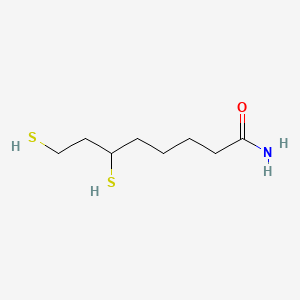| MeSH term | MeSH ID | Detail |
|---|---|---|
| Parkinsonian Disorders | D020734 | 20 associated lipids |
Dihydrolipoamide
Dihydrolipoamide is a lipid of Fatty Acyls (FA) class. Dihydrolipoamide is associated with abnormalities such as Wiskott-Aldrich Syndrome. The involved functions are known as Citric Acid Cycle, Electron Transport, NADH oxidation, Oxidation and Oxidants. Dihydrolipoamide often locates in Mitochondria, Mitochondrial matrix and Chloroplasts. The associated genes with Dihydrolipoamide are Mutant Proteins, Recombinant Proteins, mycothione reductase, Genes, Mitochondrial and alanylproline.
Cross Reference
Introduction
To understand associated biological information of Dihydrolipoamide, we collected biological information of abnormalities, associated pathways, cellular/molecular locations, biological functions, related genes/proteins, lipids and common seen animal/experimental models with organized paragraphs from literatures.
What diseases are associated with Dihydrolipoamide?
Dihydrolipoamide is suspected in and other diseases in descending order of the highest number of associated sentences.
Related references are mostly published in these journals:
| Disease | Cross reference | Weighted score | Related literature |
|---|
Possible diseases from mapped MeSH terms on references
We collected disease MeSH terms mapped to the references associated with Dihydrolipoamide
PubChem Associated disorders and diseases
What pathways are associated with Dihydrolipoamide
There are no associated biomedical information in the current reference collection.
PubChem Biomolecular Interactions and Pathways
Link to PubChem Biomolecular Interactions and PathwaysWhat cellular locations are associated with Dihydrolipoamide?
Visualization in cellular structure
Associated locations are in red color. Not associated locations are in black.
Related references are published most in these journals:
| Location | Cross reference | Weighted score | Related literatures |
|---|
What functions are associated with Dihydrolipoamide?
Related references are published most in these journals:
| Function | Cross reference | Weighted score | Related literatures |
|---|
What lipids are associated with Dihydrolipoamide?
There are no associated biomedical information in the current reference collection.
What genes are associated with Dihydrolipoamide?
Related references are published most in these journals:
| Gene | Cross reference | Weighted score | Related literatures |
|---|
What common seen animal models are associated with Dihydrolipoamide?
There are no associated biomedical information in the current reference collection.
NCBI Entrez Crosslinks
All references with Dihydrolipoamide
Download all related citations| Authors | Title | Published | Journal | PubMed Link |
|---|---|---|---|---|
| Phillips NJ et al. | Proteomic analysis of Neisseria gonorrhoeae biofilms shows shift to anaerobic respiration and changes in nutrient transport and outermembrane proteins. | 2012 | PLoS ONE | pmid:22701624 |
| Zuñiga J et al. | Cellular and humoral mechanisms involved in the control of tuberculosis. | 2012 | Clin. Dev. Immunol. | pmid:22666281 |
| Finnegan PM and Chen W | Arsenic toxicity: the effects on plant metabolism. | 2012 | Front Physiol | pmid:22685440 |
| Wang N et al. | Cloning, expression and characterization of alcohol dehydrogenases in the silkworm Bombyx mori. | 2011 | Genet. Mol. Biol. | pmid:21734824 |
| Régent A et al. | Identification of target antigens of anti-endothelial cell and anti-vascular smooth muscle cell antibodies in patients with giant cell arteritis: a proteomic approach. | 2011 | Arthritis Res. Ther. | pmid:21711540 |
| Jeffery CJ | Proteins with neomorphic moonlighting functions in disease. | 2011 | IUBMB Life | pmid:21698752 |
| Tsiveriotis K et al. | Antineutrophil cytoplasmic antibodies testing in a large cohort of unselected greek patients. | 2011 | Autoimmune Dis | pmid:21687647 |
| Mangold S et al. | Sulfur metabolism in the extreme acidophile acidithiobacillus caldus. | 2011 | Front Microbiol | pmid:21687411 |
| Picciocchi A et al. | Role of putative second transmembrane region of Nox2 protein in the structural stability and electron transfer of the phagocytic NADPH oxidase. | 2011 | J. Biol. Chem. | pmid:21659519 |
| Vanguilder HD and Freeman WM | The hippocampal neuroproteome with aging and cognitive decline: past progress and future directions. | 2011 | Front Aging Neurosci | pmid:21647399 |
| Barbieri E et al. | Morphofunctional and Biochemical Approaches for Studying Mitochondrial Changes during Myoblasts Differentiation. | 2011 | J Aging Res | pmid:21629710 |
| Thangthaeng N et al. | Nongradient blue native gel analysis of serum proteins and in-gel detection of serum esterase activities. | 2011 | J. Chromatogr. B Analyt. Technol. Biomed. Life Sci. | pmid:21237726 |
| Kareyeva AV et al. | Molecular identification of the enzyme responsible for the mitochondrial NADH-supported ammonium-dependent hydrogen peroxide production. | 2011 | FEBS Lett. | pmid:21168410 |
| Zhang Q et al. | Dihydrolipoamide dehydrogenase and cAMP are associated with cadmium-mediated Leydig cell damage. | 2011 | Toxicol. Lett. | pmid:21699967 |
| McLeod A et al. | Global transcriptome response in Lactobacillus sakei during growth on ribose. | 2011 | BMC Microbiol. | pmid:21702908 |
| Li Y et al. | The complete genome sequence of Mycoplasma bovis strain Hubei-1. | 2011 | PLoS ONE | pmid:21731639 |
| Feeney MA et al. | Repurposing lipoic acid changes electron flow in two important metabolic pathways of Escherichia coli. | 2011 | Proc. Natl. Acad. Sci. U.S.A. | pmid:21521794 |
| Smith AC and Robinson AJ | A metabolic model of the mitochondrion and its use in modelling diseases of the tricarboxylic acid cycle. | 2011 | BMC Syst Biol | pmid:21714867 |
| Roldán A et al. | Lipoamide dehydrogenase is essential for both bloodstream and procyclic Trypanosoma brucei. | 2011 | Mol. Microbiol. | pmid:21631607 |
| De Britto Mari R et al. | Quantification and morphometry of myenteric neurones in the jejunum of Holtzman rats (Rattus norvegicus). | 2011 | Anat Histol Embryol | pmid:21569076 |
